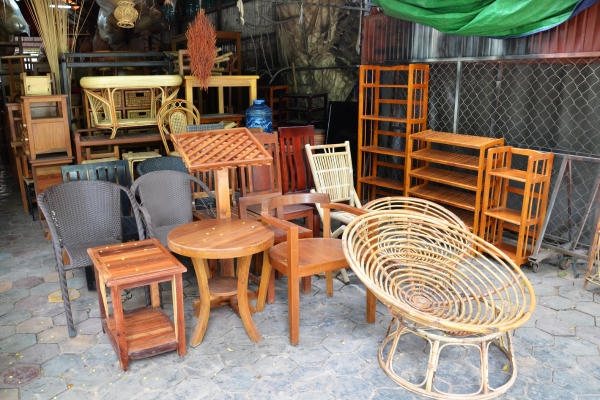Selling furniture can be a daunting task, but knowing the best places to do so can make the process seamless and profitable. Whether you’re looking to sell high-end pieces, vintage items, or everyday furniture, there are numerous platforms and locations to consider. From online marketplaces and local consignment shops to yard sales and specialized furnishing stores, each option has its own set of advantages. Understanding where to sell furnishing effectively involves assessing the value of your items, identifying your target audience, and choosing the right venue to maximize your sales. This guide will help you navigate through the various options available, ensuring you find the perfect place to sell your furniture.
Why Selling Furniture Can Be Profitable?
Selling furniture can be a highly profitable endeavor for several reasons. First, furniture often retains significant value over time, especially if it is well-maintained or considered vintage or antique. The market for second-hand furnishing is vast, encompassing budget-conscious buyers, collectors, and enthusiasts of unique or high-quality pieces. By selling your furniture, you can recoup a portion of your initial investment, sometimes even making a profit if the item has appreciated in value or if there is a high demand for a particular style or brand. Additionally, selling furniture helps reduce clutter and makes way for new pieces, adding both financial and spatial benefits to your living environment.
Preparing Your Furniture For Sale

1. Cleaning And Maintenance
Properly preparing your furniture for sale is crucial to attract potential buyers and secure the best possible price. Start by thoroughly cleaning each piece to remove dust, stains, and odors. Use appropriate cleaning solutions for different materials, such as wood polish for wooden items and fabric cleaner for upholstered furnishing. Additionally, consider making minor repairs to enhance the furniture’s condition. Tighten loose screws, fix wobbly legs, and address any scratches or dents. Well-maintained furniture not only looks more appealing but also instills confidence in buyers about the longevity and quality of the item.
2. Taking High-Quality Photos
High-quality photos are essential when selling Clean Kitchen furniture, especially on online platforms where buyers cannot inspect the item in person. Take clear, well-lit photos from multiple angles to showcase the furniture’s design and condition. Highlight any unique features or details that make the piece stand out. Use a neutral background to ensure the furnishing is the focal point of the image. Including close-up shots of any distinguishing marks or minor flaws can also help manage buyer expectations and build trust. Good photography can significantly increase interest and lead to quicker, more profitable sales.
3. Writing Compelling Descriptions
An engaging and detailed description can make a significant difference in how quickly and profitably you sell your furniture. Start by providing essential information such as the brand, model, dimensions, and materials. Describe the item’s condition honestly, mentioning any wear and tear. Highlight the furniture’s unique features, history, or any recent maintenance work that adds value. Use descriptive language to paint a vivid picture for potential buyers, helping them visualize how the piece might fit into their space. A well-written description not only attracts more interest but also helps justify your asking price, leading to more successful sales.
Where To Sell Furniture
1. eBay

eBay is a popular platform for selling furniture, offering access to a vast, global audience. This online marketplace allows sellers to list their furnishing items with detailed descriptions, high-quality photos, and set prices or auction formats. One of the key advantages of eBay is its wide reach, which increases the chances of finding interested buyers quickly. Additionally, eBay provides various tools to help sellers manage their listings, communicate with buyers, and handle transactions securely. However, shipping larger furniture items can be a logistical challenge, so it’s important to consider local pick-up options or calculate shipping costs accurately to ensure a smooth sale.
2. Facebook Marketplace

Facebook Marketplace is an excellent option for selling furniture locally. This platform leverages the vast user base of Facebook, allowing sellers to reach potential buyers in their immediate area. Listing items on Facebook Marketplace is straightforward: you can quickly post photos, descriptions, and prices, and communicate directly with interested buyers through Facebook Messenger. One of the biggest benefits is the ability to sell without shipping costs, as most transactions occur through local pick-up arrangements. Additionally, the integration with Facebook’s social network can add a layer of trust and security, as buyers and sellers often share mutual connections or belong to the same community groups.
3. Specialty Websites

Specialty websites cater specifically to furniture and home decor, attracting buyers who are actively searching for such items. Platforms like Chairish, 1stdibs, and AptDeco offer curated marketplaces for high-end, vintage, and designer furniture. These sites often provide additional services, such as professional photography, item verification, and shipping logistics, which can enhance the selling experience. Listing on specialty websites can yield higher prices due to the targeted audience willing to pay a premium for unique or high-quality pieces. However, these platforms may charge listing fees or a commission on sales, so it’s important to factor these costs into your pricing strategy.
4. Consignment Stores
Consignment stores are a great option for selling furniture, particularly if you prefer a hands-off approach. These stores take your furnishing and sell it on your behalf, typically for a commission. The advantage of using a consignment store is that they handle all aspects of the sale, including marketing, pricing, and interacting with buyers. This can be especially beneficial for higher-end or unique pieces, as consignment stores often have a customer base specifically looking for quality furniture. However, the commission fees can vary, so it’s important to understand the terms and ensure the potential profit aligns with your expectations.
5. Auction Houses

Auction houses provide an excellent venue for selling valuable or antique furniture. These establishments attract buyers who are specifically interested in high-quality, unique, or collectible pieces. Selling through an auction house can potentially yield high returns, especially if there is significant interest in the item. The auction process involves experts who appraise your furniture and set a starting bid, ensuring your pieces are appropriately valued. However, auction houses also charge fees for their services, and the final sale price can be unpredictable, depending on the level of buyer interest during the auction.
6. Local Options
Exploring local options for selling furniture can be both convenient and cost-effective. Hosting a garage or yard sale allows you to sell items directly to neighbors and local residents, often without any additional fees. This option is particularly useful for quickly getting rid of multiple items at once. Additionally, local classified ads, community bulletin boards, and local online marketplaces such as Craigslist offer platforms to reach potential buyers within your area. Selling locally typically avoids shipping costs and simplifies transactions, making it easier to coordinate pick-ups and payments directly with buyers.
7. Garage Sales

Garage sales are a traditional and effective way to sell furniture locally. They provide an opportunity to quickly offload multiple items and reach a wide range of buyers within your community. Hosting a garage sale allows you to set your own prices, negotiate directly with buyers, and avoid shipping costs or listing fees associated with online platforms. Additionally, the casual and open nature of garage sales can attract a variety of customers, from bargain hunters to neighbors looking for specific pieces. To maximize success, advertise your garage sale through local newspapers, online community boards, and social media to draw a larger crowd.
8. Charitable Donations

If you’re looking to sell furniture for a good cause or simply want to declutter quickly, charitable donations can be a rewarding option. Many organizations, such as Habitat for Humanity ReStores, Goodwill, and local shelters, accept furnishing donations and often provide a tax deduction receipt for your contributions. Donating your furniture can benefit those in need and support community programs while also providing you with a sense of giving back. Ensure that the items you wish to donate are in good condition and contact the charity beforehand to confirm their acceptance policies and arrange for pick-up or drop-off.
What Should I Do If My Furniture Doesn’t Sell?
If your furniture doesn’t sell, there are several strategies you can employ to increase your chances of finding a buyer. First, reassess your pricing; it might be too high for the current market. Consider lowering the price to attract more interest. Second, enhance your listing by updating photos and descriptions to make them more appealing. Highlight any unique features or benefits that may have been overlooked. Third, expand your sales channels by listing your furnishing on multiple platforms or exploring different selling venues, such as local classified ads or additional online marketplaces. If these efforts still don’t yield results, consider alternative options like donating the furniture to a charitable organization, giving it away to friends or family, or repurposing it creatively to fit your own needs.
Conclusion
Selling furniture can be a profitable and satisfying endeavor when approached strategically. By choosing the right platform, whether it’s eBay, Facebook Marketplace, specialty websites, consignment stores, auction houses, or local options, you can reach a wide audience and maximize your sales potential. Preparing your furniture properly by cleaning, taking high-quality photos, and writing compelling descriptions is essential to attract buyers. If your furnishing doesn’t sell, don’t be discouraged—adjust your strategy, try different venues, or consider donation as a meaningful alternative. With persistence and the right approach, you can successfully sell your furniture and achieve your desired outcomes.
